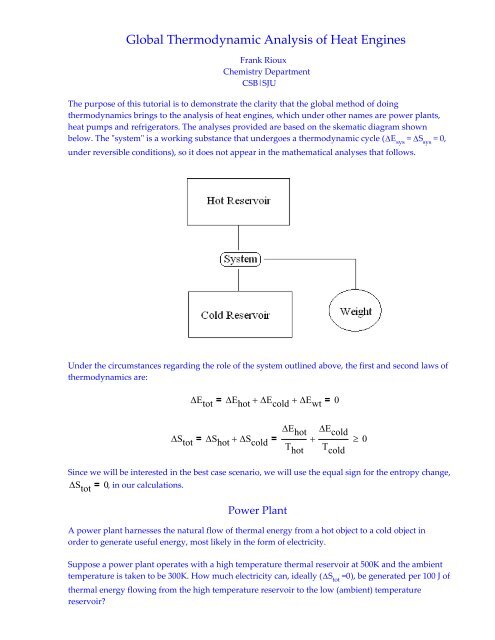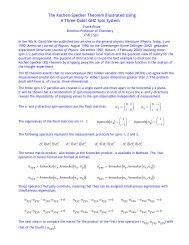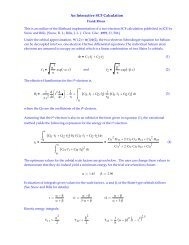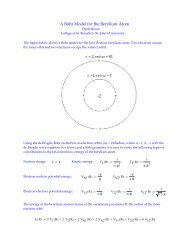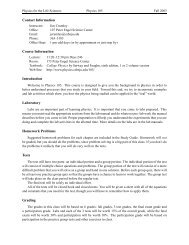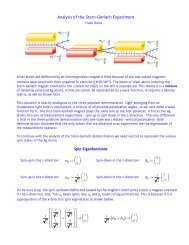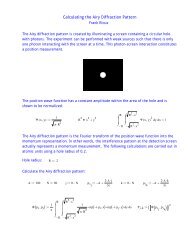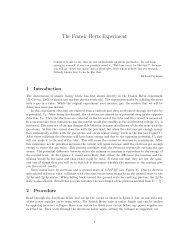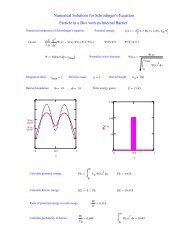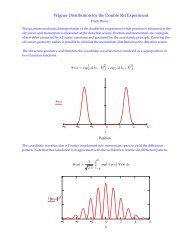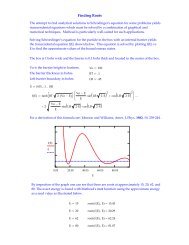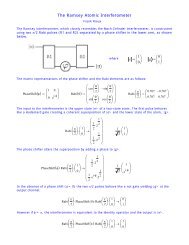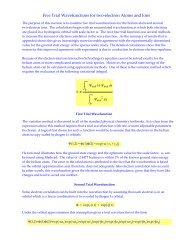Mathcad - HeatPump.mcd - Users.csbsju.edu
Mathcad - HeatPump.mcd - Users.csbsju.edu
Mathcad - HeatPump.mcd - Users.csbsju.edu
- No tags were found...
You also want an ePaper? Increase the reach of your titles
YUMPU automatically turns print PDFs into web optimized ePapers that Google loves.
Global Thermodynamic Analysis of Heat EnginesFrank RiouxChemistry DepartmentCSB|SJUThe purpose of this tutorial is to demonstrate the clarity that the global method of doingthermodynamics brings to the analysis of heat engines, which under other names are power plants,heat pumps and refrigerators. The analyses provided are based on the skematic diagram shownbelow. The ʺsystemʺ is a working substance that undergoes a thermodynamic cycle (ΔE sys= ΔS sys= 0,under reversible conditions), so it does not appear in the mathematical analyses that follows.Under the circumstances regarding the role of the system outlined above, the first and second laws ofthermodynamics are:ΔE tot = ΔE hot + ΔE cold + ΔE wt = 0ΔS tot = ΔS hot + ΔS cold=ΔE hotT hotΔE cold+ ≥ 0T coldSince we will be interested in the best case scenario, we will use the equal sign for the entropy change,ΔS tot = 0, in our calculations.Power PlantA power plant harnesses the natural flow of thermal energy from a hot object to a cold object inorder to generate useful energy, most likely in the form of electricity.Suppose a power plant operates with a high temperature thermal reservoir at 500K and the ambienttemperature is taken to be 300K. How much electricity can, ideally (ΔS tot=0), be generated per 100 J ofthermal energy flowing from the high temperature reservoir to the low (ambient) temperaturereservoir?
The defined parameters are highlighted, while the calculated quantities are un‐highlighted.ΔE wt := ΔE wt ΔE hot := −100⋅JΔE cold := ΔE cold T hot := 500⋅KT cold := 300⋅K( ΔE wt ΔE cold ):=⎛⎜⎜⎜⎝ΔE hot+ ΔE cold + ΔE wt = 0ΔE hot ΔE cold+ = 0T hot T cold⎞⎟⎟⎟⎠solve ,float,3⎛⎜⎜⎝ΔE wtΔE cold⎞⎟⎟⎠→⎛⎜⎝40. ⋅J60. ⋅J⎞ ⎟⎠It is clear from this analysis that the power plant is theoretically 40% efficient:ΔE wt= 40%ΔE hotHeat PumpNon‐spontaneous processes occur when they are driven by some other spontaneous process, such asdescribed in the previous example.Heat pumps are in the news again today, as they were in the late 70s and early 80s. Here we ask thequestion of how much energy we can pump from the ambient thermal environment into a house bybuying 100 J of energy from the local utility. We assume that the ambient thermal source temperatureis 270K and the house is being maintained at 300K.ΔE wt := −100⋅JΔE hot := ΔE hot ΔE cold := ΔE cold T hot := 300⋅KT cold := 270⋅K⎛⎜⎜⎜⎝ΔE hot+ ΔE cold + ΔE wt = 0ΔE hot ΔE cold+ = 0T hot T cold⎞⎟⎟⎟⎠solve ,float,4⎛⎜⎜⎝ΔE hotΔE cold⎞⎟⎟⎠→ [ 1000. ⋅J( −900.) ⋅J]This remarkable result shows that by buying 100 J from the local utility one can pump 1,000 J ofthermal energy from the ambient source into the house. Again this is assuming the ideal, theoreticallimit, ΔS tot=0.RefrigeratorA refrigerator is also a heat pump. However, with a refrigerator we are interested in how muchenergy we can pump out of the low temperature reservoir (the contents of the refrigerator) at acertain cost, rather than how much we can deliver to the high temperature reservoir. Here we askhow much energy we must purchase to pump 100 J out of the refrigerator.ΔE wt:= ΔE wt ΔE hot := ΔE hot ΔE cold := −100⋅JT hot := 300⋅KT cold := 280⋅K
⎛⎜⎜⎜⎝ΔE hot+ ΔE cold + ΔE wt = 0ΔE hot ΔE cold+ = 0T hot T cold⎞⎟⎟⎟⎠solve ,float,4⎛⎜⎜⎝ΔE hotΔE wt⎞ ⎟⎟ ⎠→ [ 107.1⋅J( −7.143) ⋅J]This result tells us something we already know, but doesnʹt obtrude on our senses: operating arefrigerator is not particularly expensive. One hundred joules can be pumped out of therefrigerator for a cost of just over 7 joules, under ideal circumstances.


